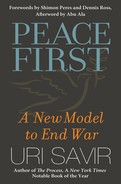INTRODUCTION
The Modern Process
NEARLY ALL PEACEMAKING TODAY TAKES PLACE BEHIND CLOSED doors. Small groups of diplomats and leaders gather in private settings to produce documents that are supposed to represent the interests of many. Even if that elite group understands the value of the four pillars of modern peace, however, avoiding the traps of historical treaties requires actively building the peacemaking process on those modern ideals.
Glocalization, peace ecology, peacebuilding, and creative diplomacy emphasize the civilian aspects of peacemaking and are therefore a natural progression in its evolution. Part 3 explains how these four pillars need to be the foundation on which peace is planned, negotiated, and built. Rather than presenting the modern process as one size fits all, I have tried to present the conditions and approaches that, in my experience and studies, provide the greatest potential to build lasting, sustainable peace from the ground up. In other words, although I hope to see my specific recommendations put into action, the more important point is the reasoning behind these recommendations. I recognize that governments and cultures operate according to different perceptions and methods; I believe that the principles behind the modern process can offer positive guidance for any conflict-resolution situation, anywhere.
This section is not written merely for professional peacemakers, as a blueprint for the modern process; it also is an attempt to throw open the closed doors of peacemaking and to invite the scrutiny and participation of the greater society. By making the process more transparent, I hope to give citizens a way to engage more directly with peacemaking. The modern process must not 84 be a series of secretive encounters but an open and welcoming approach, involving the interaction of two societies in addition to two negotiating teams. Citizens will have the opportunity to communicate their unique needs, and those at the helm of the process will have the opportunity both to support and to depend on the populations they represent.
The road to peace is never a straight line, but as long as we are guided by the principles of the four pillars we can at least keep ourselves pointed in the right direction.
